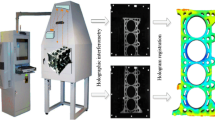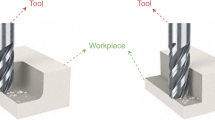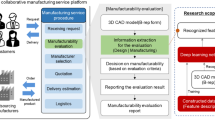Abstract
Most mechanical part models in current industrial manufacturing are composed of multiple different machining features. However, the traditional rule-based feature recognition methods are only suitable for analyzing simple and specific features. Although the existing methods based on deep learning are no longer limited to recognizing particular features, they cannot recognize complex overlapping features. To solve the above issues, this paper proposed a machining feature recognition approach based on the hierarchical neural network to recognize the multiple features on point cloud models. Firstly, the 3D models were converted into point cloud samples to construct the dataset, so that the approach could be applied to different 3D model formats. Then a hierarchical neural network called PointNet++ for single feature recognition was constructed. For the multi-feature point cloud models, a feature segmentation method was proposed to divide a complex multi-feature model into single feature models for recognition. Finally, the approach was evaluated on the created test data sets. The test results show that the overlapping machining feature on point cloud models can be accurately recognized with low computational cost.













Similar content being viewed by others
Data availability
The used data and materials are available when requested.
Code availability
The used code is available when requested.
References
Abadi, M., Agarwal, A., Barham, P., Brevdo, E., Chen, Z., Citro, C., Corrado, G. S., Davis, A., Dean, J., Devin, M., Ghemawat, S., Goodfellow, I. J., Harp, A., Irving, G., Isard, M., Jia, Y., Józefowicz, R., Kaiser, L., Kudlur, M., … Zheng, X. (2016). Tensorflow: Large-scale machine learning on heterogeneous distributed systems. arXiv preprint arXiv:1603.04467.
Bassier, M., Bonduel, M., Van Genechten, B., & Vergauwen, M. (2017). Segmentation of large unstructured point clouds using octree-based region growing and conditional random fields. The International Archives of the Photogrammetry, Remote Sensing and Spatial Information Sciences, 42(2W8), 25–30.
Ben-Shabat, Y., Lindenbaum, M., & Fischer, A. (2018). 3dmfv: Three-dimensional point cloud classification in real-time using convolutional neural networks. IEEE Robotics and Automation Letters, 3(4), 3145–3152.
Bowers, J., Wang, R., Wei, L.-Y., & Maletz, D. (2010). Parallel Poisson disk sampling with spectrum analysis on surfaces. ACM Transactions on Graphics (TOG), 29(6), 1–10.
Hackel, T., Savinov, N., Ladicky, L., Wegner, J. D., Schindler, K., & Pollefeys, M. (2017). Semantic3d. net: A new large-scale point cloud classification benchmark. arXiv preprint arXiv:1704.03847.
ISO, I. (2003). 14649-1. Industrial automation systems and integration—physical device control—data model for computerized numerical controllers—Part 1: Overview and fundamental principles. International Organization for Standardization.
Joshi, S., & Chang, T.-C. (1988). Graph-based heuristics for recognition of machined features from a 3D solid model. Computer-Aided Design, 20(2), 58–66.
Krot, K., & Czajka, J. (2018). Processing of design and technological data due to requirements of computer aided process planning systems. In International conference on intelligent systems in production engineering and maintenance (pp. 267–274). Springer.
Lamikiz, A., De Lacalle, L. L., Sánchez, J. A., & Salgado, M. (2005). Cutting force integration at the CAM stage in the high-speed milling of complex surfaces. International Journal of Computer Integrated Manufacturing, 18(7), 586–600.
López de Lacalle*, L., Lamikiz, A., Muñoa, J., & Sánchez, J. (2005). The CAM as the centre of gravity of the five-axis high speed milling of complex parts. International Journal of Production Research, 43(10), 1983–1999.
Malyshev, A., Slyadnev, S., & Turlapov, V. (2017). Graph-based feature recognition and suppression on the solid models. In GraphiCon (pp. 319–322).
Ning, F., Shi, Y., Cai, M., & Xu, W. (2020). Various realization methods of machine-part classification based on deep learning. Journal of Intelligent Manufacturing, 31(8), 2019–2032.
Qi, C. R., Su, H., Mo, K., & Guibas, L. J. (2017a). Pointnet: Deep learning on point sets for 3d classification and segmentation. In Proceedings of the IEEE conference on computer vision and pattern recognition (pp. 652–660). https://doi.org/10.1109/CVPR.2017.16
Qi, C. R., Yi, L., Su, H., & Guibas, L. J. (2017b). Pointnet++: Deep hierarchical feature learning on point sets in a metric space. In Advances in neural information processing systems, vol. 30. Curran Associates, Inc. https://proceedings.neurips.cc/paper/2017/file/d8bf84be3800d12f74d8b05e9b89836f-Paper.pdf
Rossetti, G., Milli, L., & Cazabet, R. (2019). CDLIB: A python library to extract, compare and evaluate communities from complex networks. Applied Network Science, 4(1), 1–26.
Shi, P., Qi, Q., Qin, Y., Scott, P. J., & Jiang, X. (2020). A novel learning-based feature recognition method using multiple sectional view representation. Journal of Intelligent Manufacturing, 31(5), 1291–1309.
Su, H., Maji, S., Kalogerakis, E., & Learned-Miller, E. (2015). Multi-view convolutional neural networks for 3d shape recognition. In Proceedings of the IEEE international conference on computer vision (pp. 945–953). https://doi.org/10.1109/ICCV.2015.114
Venu, B., Komma, V. R., & Srivastava, D. (2018). STEP-based feature recognition system for B-spline surface features. International Journal of Automation and Computing, 15(4), 500–512.
Weise, J., Benkhardt, S., & Mostaghim, S. (2018). A survey on graph-based systems in manufacturing processes. In 2018 IEEE symposium series on computational intelligence (SSCI) (pp. 112–119). IEEE.
Woo, T. C. (1982). Feature extraction by volume decomposition. In Proceedings of conference in CAD/CAM technology in mechanical engineering (pp. 76–94).
Wu, Z., Song, S., Khosla, A., Yu, F., Zhang, L., Tang, X., & Xiao, J. (2015). 3d shapenets: A deep representation for volumetric shapes. In Proceedings of the IEEE conference on computer vision and pattern recognition (pp. 1912–1920). https://doi.org/10.1109/CVPR.2015.7298801
Xie, J., Dai, G., Zhu, F., Wong, E. K., & Fang, Y. (2016). Deepshape: Deep-learned shape descriptor for 3d shape retrieval. IEEE Transactions on Pattern Analysis and Machine Intelligence, 39(7), 1335–1345.
Zhang, L., & Zhu, Z. (2019). Unsupervised feature learning for point cloud understanding by contrasting and clustering using graph convolutional neural networks. 2019 international conference on 3D vision (3DV) (pp. 395–404). IEEE.
Zhang, Z., Jaiswal, P., & Rai, R. (2018). Featurenet: Machining feature recognition based on 3d convolution neural network. Computer-Aided Design, 101, 12–22.
Funding
This work was supported by the National Natural Science Foundation of China (Grant No. 52175278), and the Key R&D Program of Zhejiang Province (Grant No. 2021C01145).
Author information
Authors and Affiliations
Contributions
Ms. Wang, Ms. Yu contributed equally in planning and conducting the experiments and analysis, as well as in preparing the manuscript. Dr. Yao, Dr. Luan, Prof. Fu contributed by supervising, conceptualizing, reviewing, and editing the manuscript.
Corresponding author
Ethics declarations
Conflict of interest
Not applicable.
Consent to participate
Not applicable.
Consent for publication
Not applicable.
Ethical approval
The submitted work is original and has never been published elsewhere in any form or language.
Additional information
Publisher's Note
Springer Nature remains neutral with regard to jurisdictional claims in published maps and institutional affiliations.
Supplementary Information
Below is the link to the electronic supplementary material.
Rights and permissions
About this article
Cite this article
Yao, X., Wang, D., Yu, T. et al. A machining feature recognition approach based on hierarchical neural network for multi-feature point cloud models. J Intell Manuf 34, 2599–2610 (2023). https://doi.org/10.1007/s10845-022-01939-8
Received:
Accepted:
Published:
Issue Date:
DOI: https://doi.org/10.1007/s10845-022-01939-8




